Artspeak and Kung Fu
An exchange between artists Sean Smuda and Nickelangelo (a.k.a. Nick Vlcek, a longtime art director of City Pages) on the intersection of language, contemporary art, kung fu and everyday visual delight .
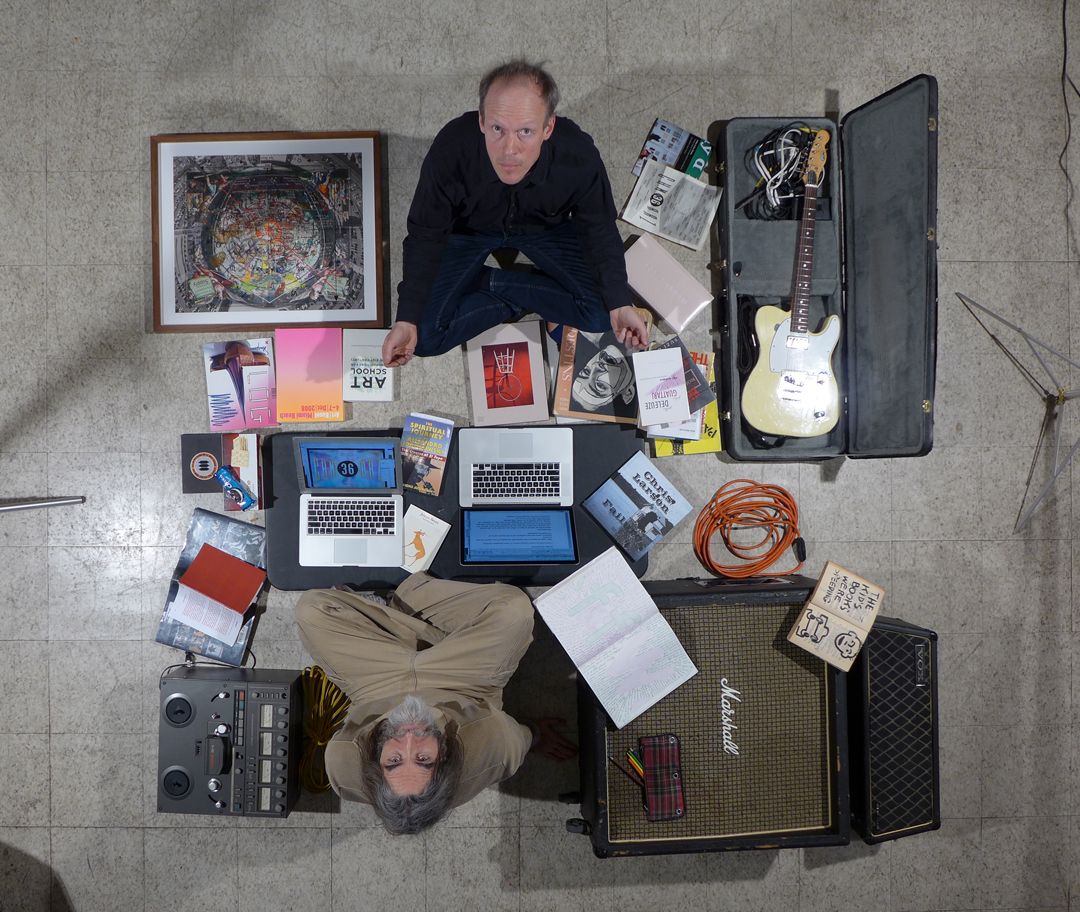
36CHMBRZ is a sprawling, ambitious investigation into art-of-the-moment that stretches the limits of the domestic setting of TuckUnder Projects. Nickelangelo is an emerging artist, born late in life out of the person whose work you probably saw as Nick Vlcek, art director of the City Pages alternative weekly for nearly a decade. It was there he first met Sean Smuda—artist, gallerist, and photographer—who is now appearing as ‘Special Guest’ in this final TuckUnder show of the season.
Sean Smuda
Break down the central “chambers” concept for us.
Nickelangelo
The conceit for the show is based on The 36th Chamber of Shaolin, a classic kung fu flick from the late seventies. It’s about a guy who trains at the legendary temple in order to learn the badass fighting skills he needs to help defend his people. The chambers are the techniques he learns along the way. RZA was inspired by the film while forming the Wu-Tang Clan and called their first album Enter the Wu-Tang (36 Chambers).
Sean
Wu-Tang! I didn’t know you were all about kung fu. What about getting physical in the artworld?
Nickelangelo
I’ve had some martial arts training, but I’m not a practitioner. It will always fascinate me, though. I suppose you could say some artworld behavior is akin to a mental form of kung fu, but a dance analogy is probably more accurate.
Sean
Why is that?
Nickelangelo
Dance is more a creative partnership than it is a means to domination. Anyway, for this work I likened the story of learning the martial art techniques and spiritual teachings of the temple to what I have been studying in contemporary art, and came up with my own list of the “chambers” I’ve encountered in the process — which are ever growing, ever changing.
Sean
Such as?
Nickelangelo
Abdication, antagognosis, atemporality, autonomy…
Sean
Hold up. Antagognosis?
Nickelangelo
Yeah, kinda made that one up. It has to do with understanding and becoming comfortable with the evolutionary and revolutionary cycles of agonistic and antagonistic action, and with the necessity for personal and public agitation at times, in maintaining balance and growth.
Sean
An antidote to Minnesota Nice, perhaps? I notice that a lot of your work deals with words and language.
Nickelangelo
Yes, I’m interested in language and, specifically, questions about language. You can’t come close to the contemporary artworld and not collide with the language of “artspeak” and the concepts that go with it. As you begin to understand it, a new world opens up and a lot of what was once impenetrable starts to make sense. So, the chambers premise in this project was my chance to analyse and create work around a charged series of those themes. People who have visited the show ask, “Is there a one-to-one relationship between the artworks and the ideas?” In some cases, yeah, but in general they are the concepts I was working with at large, and they overlap in their application.
Sean
How did you hook up with TuckUnder Projects?
Nickelangelo
I responded to an open call for projects. Pete Driessen, who runs the gallery space out of the back of his house in South Minneapolis, OK’d my proposal, and that was it. Because of the large number of pieces in the show, we extended the exhibition space for 36CHMBRZ to cover the front lawn, the walkway, the patio, the backyard and second garage, as well as the TuckUnder gallery itself.
Sean
Don’t forget the bathroom!
Nickelangelo
And the kitchen, too, with Aki Shibata’s cooking performance. But it’s the Leaky Sink Gallery [i.e. the bathroom] that brought you and me together again after all these years. When Pete asked if I needed that space, and I found I didn’t, I wondered about who could create some magic in such a confined area. And you really pulled it off!
Sean
We’ll get to that. I thought you dreamed me into the project — aren’t I the first person in your dream diary?
Nickelangelo
Yes, I’d forgotten that. The study of dream travel and the way dreams interact with waking life is called oneironautics. I’m very interested in realms of the immaterial as fertile ground for generating art. The record I made of my experiences in the dream state in the months leading up to the show was a natural expression of that. Then I had this amazing experience on opening night, when I opened the journal at random to a recorded dream that described the very scene that was taking place in that moment. I got ASMR chills!
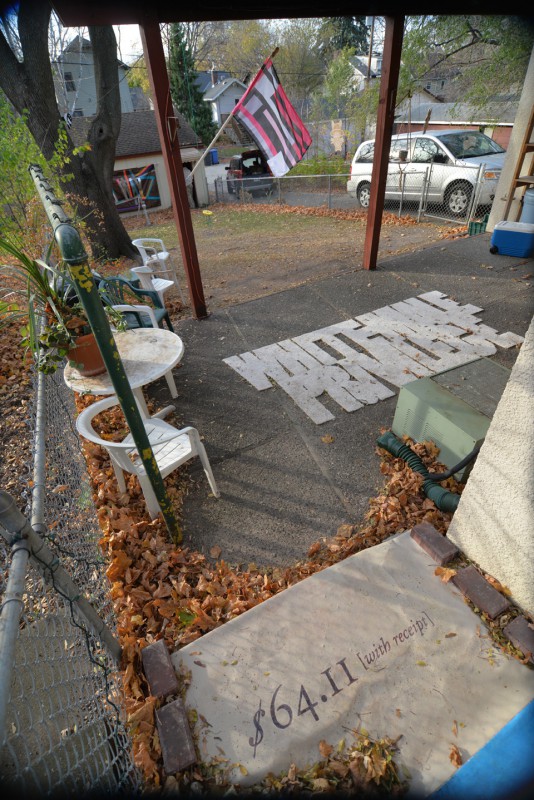
Installation view of the “step paintings” by Nickelangelo. Photo: Sean Smuda
Sean
Talk a bit about the “step paintings”?
Nickelangelo
I’ve always been taken with the experience of entering the TuckUnder space by walking down the steps at the side of the house, so I wanted to include that somehow, to immediately engage guests as they make their way inside. I made the canvases for that spot, large enough so there would be no way to avoid stepping on them. And by painting ultra-fat, the pigment was still wet enough to allow the colors to cross pollinate and interact, over time, with the elements to come, like leaves, rain, and snow.
Sean
And the numbers on the paintings themselves?
Nickelangelo
Those are numerical references to stories in art history, for the most part, points of inflection between commerce and art. Then, at the bottom, you have a chance to wipe your shoes —
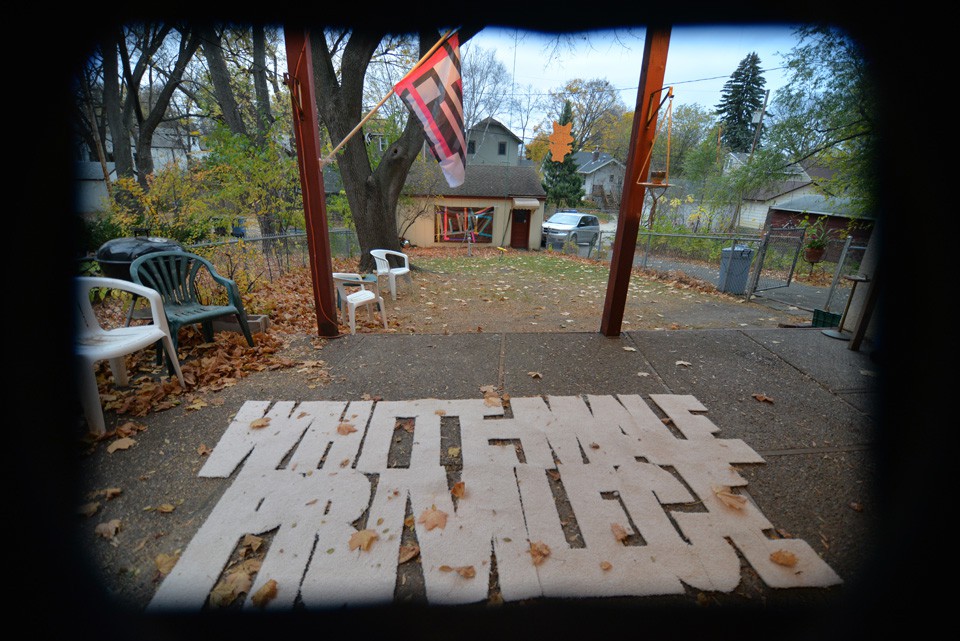 Nickelangelo, Foundation of Western Art. Photo: Sean Smuda
Nickelangelo, Foundation of Western Art. Photo: Sean Smuda
Sean
— on White Male Privilege!
Nickelangelo
The carpet. The actual title of the piece is Foundation of Western Art. Had to call it out. Acknowledge it, wipe your feet, and move on to something new.
Sean
Then, before us on the shelf, we see curled up little soaps on a soap dish. Explain.
Nickelangelo
Bob Rauschenberg famously spoke about working in the gap between art and life. In many ways that gap hasn’t just disappeared, those circles now overlap, like a Venn diagram. It’s the full fruition of Pop. In a networked society, all day long we recognize, snap, and post the world of art that surrounds us. There’s visual delight, even in the quotidian. So, the soap will have a moment of glory, then it’ll go back into the shower. My wife will be happy.
Sean
Clean up your act! Many of your pieces seem deeply personal, yet blown-up big, almost cartoonish—like your new artistic moniker [Nickelangelo].
Nickelangelo
I was deeply influenced by the collage that Bart Ryan put together as 9 Artists last year at the Walker. To me, the glue connecting those artists’ works was the construction of persona, the understanding we have of ourselves in relation to others, and how we choose to project that character. Which is germane to how we consume art today: We want to know as much about the artist as the work itself. The knowledge of one feeds of our knowledge of the other. Lane Relyea speaks to this in Your Everyday Art World. Art practice, now, is as much about who we are and where we fit in as it is about the actual work we produce.
Sean
So you’re running with it?
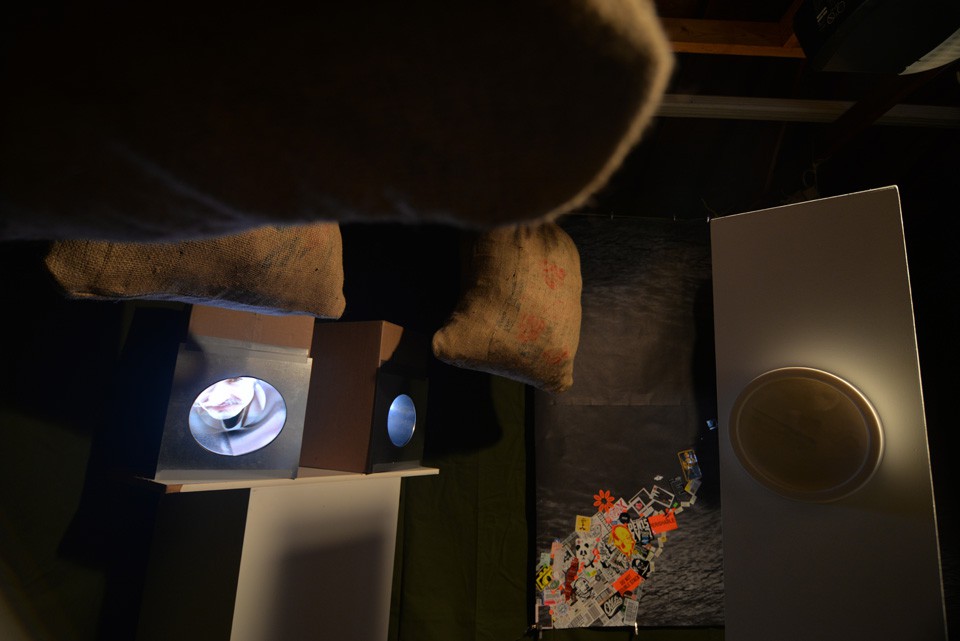 Installation view of 36CHMBRZ. Photo: Sean Smuda
Installation view of 36CHMBRZ. Photo: Sean Smuda
Nickelangelo
Sliding down the rope on it, more like, trying to tie it all together. Like the jute sacks hanging in the TuckUnder garage: they allude to a scene in the 36 Chambers movie, but they’re also my personal re-manifestation of the Duchampian coal bags. Only, instead of coal, I’ve stuffed the sacks with old copies of City Pages, one bag for each year I worked there.
Sean
A time when I was but a poor slave photographer to your master, as the art director.
Nickelangelo
Hardly. It was I who was in service to you and all the other artists I worked with there. That was the best part of the job, being able to give opportunities for creative work, and to pay for it. I never self-identified as an artist at that point, only as someone presenting the work of others.
Sean
If I’d only known! I thought you did whatever you wanted.
Nickelangelo
I had limited autonomy, but publishing is a collaborative effort, and ultimately newspapers are about words, not images. As art director, I was there to get foot-traffic in the door, visually. You live or die in that two-second first glance. We called it the ‘ten-foot rule’: being a free paper, either you get a passerby to pick up, or you don’t.
Sean
An artist in your own right, now you have full creative freedom, expressed in the many different kinds of media in this show—ceramics, video, books, prints. You’ve obviously been crazy busy. Some of this work seems to be uniquely you; but, ironically maybe, some of it also shows the influence of other artists. You’re wearing your heart on your sleeve—no, on your capri pants, more accurately.
Nickelangelo
I’d call them knickerbockers. But, yeah, there are references to other artist’s work here. I’m OK with a conscious call-and-response in the right place. I find some works demand this. Molly Zuckerman-Hartung’s Notley is like that for me—seeing that work started the process that led me to the tape painting you’ll see hanging outside the garage in this show.
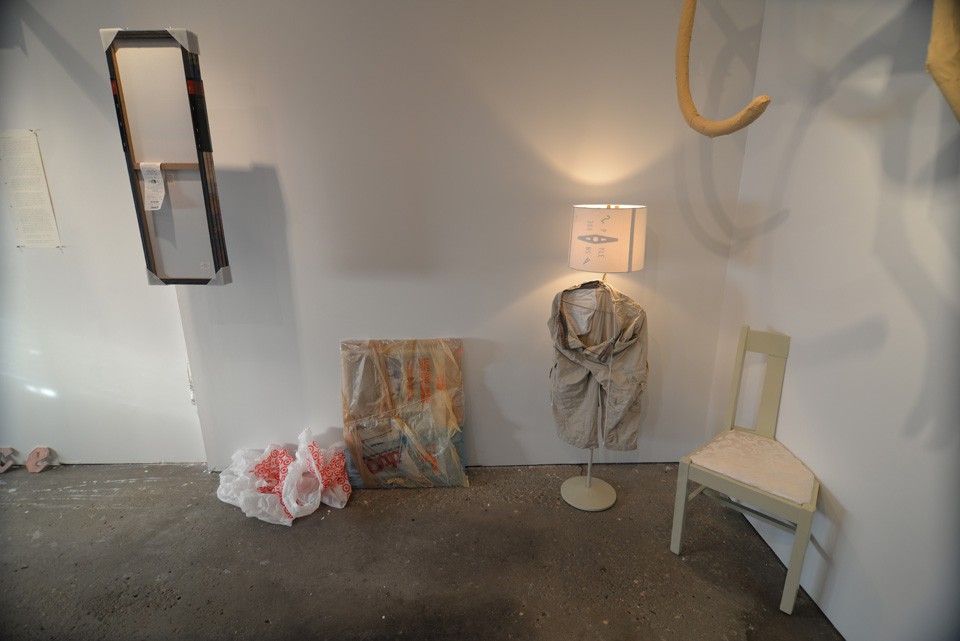 Installation shot by Sean Smuda
Installation shot by Sean Smuda
Sean
On a related note: What’s your obsession with Chris Larson?
Nickelangelo
Who doesn’t love that guy? He’s a big anchor in this community, showing how you can have it all—family, artistic success, and the means by which to share it. And, hey, the photo shoot parody was your idea!
Sean
Fair enough. (Readers, you’re going to have to wiki the movie if you haven’t seen it yet to get this next question:) What is your 36th chamber?
Nickelangelo
For me, it’s close to the same idea as in the movie, where the last chamber takes the work into the world. A friend came to the TuckUnder show recently and really nailed it. She stood outside the gallery space in the backyard and looked out onto the alleyway and had an epiphany, about how the alley is like a giant subconscious stream where people dream collectively, with the church tower at the end of the block acting like a two-way broadcast beacon. That’s my highest hope in exhibiting art: Not admiration for the work, but to help trigger some kind of revelation, a peek into the structure of the mystery all around us.
youtube://v/0e17VCwRMJo
Sean
So you’re creating a state of appreciation? But isn’t that a paradox? It’s a chamber, after all, which calls into question a relation between the world and the hermetic. I have been referring to my installation, Target Classes, as the “infinity chamber.”
Nickelangelo
I think you’re adhering to the definition of “chamber” too exactly. In this instance, I think it’s more of a training arena or classroom than a physically isolated room. But I‘m intrigued by your notion—it sounds something like recursion, which is one of the themes I worked with, like the piece, Didactic, that folds into itself.
Sean
Yes, but don’t you feel that, until your dialogues with other artists are answered [in kind], they too are recursive?
At any rate, I’ve been calling the installation in the Leaky Sink Gallery that because I think of it as, literally, an infinity of reflections about the cognitive dissonance of the post 9/11 era and the merging of the divide between the self and the other. My piece begins with a computer reading a text that ties together Edina and Baghdad.
Nickelangelo
I tried to address that notion directly in a couple of pieces myself: the video in the garage and the twin hoodies that hang in the main gallery. Those works were a reaction to the Ferguson tragedy, the fear inherent in the misidentification of otherness that led to the killing.
Sean
That’s the true training of art: a compassionate/intellectual adventure that should be in police training manuals right next to first-person shooter scenarios and hostage situations. Is the art holding you and me hostage? Or, have we developed Stockholm Syndrome?
Nickelangelo
Ha! I love the notion of an art that is practical enough to be deployed in times of crisis. I’m afraid language would often muddy this up. Can we communicate more clearly through actions and images? Sometimes, the answer is: yes.
Sean
Pardon my jumping contexts here, but I think there’s legwork that needs to be done, by both artist and viewer, to guide and enable the empathetic/sympathetic response. Hell, I’d settle for a pathetic response.
Nickelangelo
Well, I was struck by the sheer density of information in your work at first, but as you’ve animated the piece through movement, the individual layers come to life as distinct voices, like characters in a play.
Sean
Yes, my performance is about activating that density. I feel that, as a set, the series hangs well enough that one can become immersed in its intentions. However, as individual pieces, they may appear as overburdened “emergencies” of information. The performance helps unpack those layers. The pieces combine current informational imagery with the same from the 17th century. The concerns of the work have to do with narratives: who gets to write history, who gets to revise it? I am providing the viewer with trans-historic patterns sufficient for them to write their own history. Target Classes, the piece used in the performance, is a fail in the same way that surfing the Internet all day is a fail, if you don’t curate your research. Yet, the pieces in my Universal Harmony series are deliberately overwhelming, because that’s where we, and perception itself, are at in 2014.
Nickelangelo
Could you elaborate on the reference to Dutch colonialism in your work? Do you see a link to today’s overanxious consumerism?
Sean
The way that the Dutch committed near-genocide on the Banda Islanders in their pursuit of nutmeg strikes me as directly parallel with Operation Infinite Oil. Oil enables the current paradigm’s bourgeois society in a way similar to that of the Dutch spice trade in the 17th century. As opposed to the ermines of yore bought with nutmeg lucre, we have the mainstream designer threads that express a kind of austerity largesse, via Targét, neatly enabled by anyone using petroleum by-products. Which is all of us. My piece should hang triumphantly in Brian Cornell’s [Target CEO] corner office!
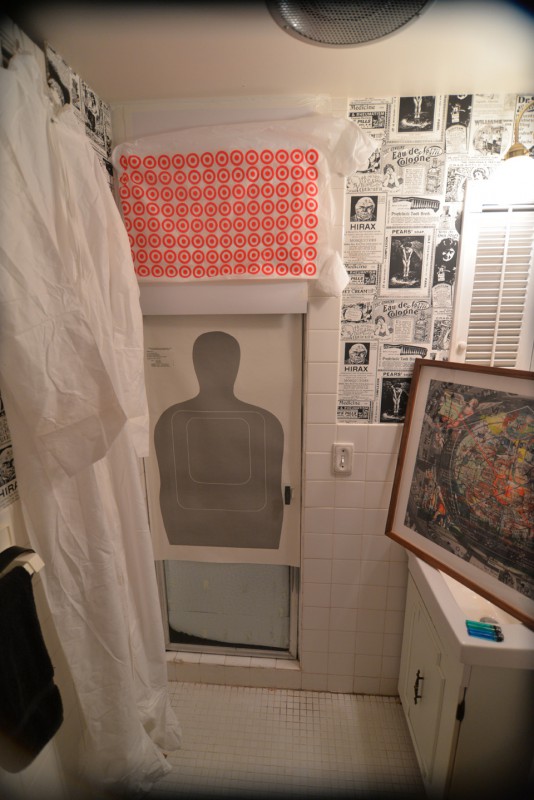
Installation view of Sean Smuda’s Target Classes. Photo by the artist.
Nickelangelo
Right next to the simulacrum of gentle abstraction that I called Many Happy Returns: the polyvinyl, three-piece painting set manufactured in China — yours for $64.11. Do we really need to go to a big-box retailer in city teeming with artists to find something to hang on the walls?
Sean
It’s a kind of consumerism that has co-opted a once anti-consumerist aesthetic into itself. Anyone’s wholesome paradigm of subsistence, whether they shop at Target or a CSA, can’t help but participate in both the damage and good that this sort of consumer relationship perpetuates.
Nickelangelo
Tell me about your sources.
Sean
I went up, from the inception of the internet to its current iteration, which is a kind of reverse vanishing point. The subsequent over-emergence of information that has subsumed the (this) individual has triggered a kind of fight/flight extension in my work that feeds into its physicality. So, during the performance, a computer voice speaks to this overload and also explains the visual/historical sources in the piece: the birth chart of Julian Assange (progressed); an aerial photograph of NSA headquarters; Harmonia Macrocosmica, plate 26, depicting an exoticized colonial zoology and mythology. As one of the 17th-century Harmonia Macrocosmica map set, which I’ve completely appropriated for this series, that last is a minor piece. But, somehow, to me its imagery of the unicorn, serpent, and dragon expresses the relationships between Assange, the NSA, and daily crude oil consumption. That image says something about the ways they all struggle for your attention – whether it’s by way of a message of wariness, of vigilance or in the communication of a sense of necessity to interact with the dominant energy paradigm.
Nickelangelo
I’m not sure I see how those three come together.
Sean
By their association, I am implicating the connection between surveillance and consumption as a self-perpetuating narrative. But I’m also suggesting that, as authors ourselves, each of us can take this received narrative and transform it in turn.
Target Classes is named after a graphic from a presentation entitled Human Values as Strange Attractors. At the World Futures Studies conference in Helsinki in 1993, its presenters classed human values in terms of different intensities and phases. They argue that our “values,” such as freedom and diversity, are drawn (like the planetary orbits to which the presentation’s title refers) to periodic, point, pattern, or strange attractors. And as they’re so drawn, we find like values from these other directions or “classes” with which they’re associated. And, as we continue, these values may expand slowly like a star, become dogmatic in fixed orbits, fizzle in the void, or create their own patterns. The talk was based on chaos theory, which was crazy hot at the time, but it seems to me that the notions here, about the way values shift and combine, relate equally well to anyone’s path.
Nickelangelo
It’s recursion again, this time as the fractal orbit. I like your empowerment of the viewer as author.
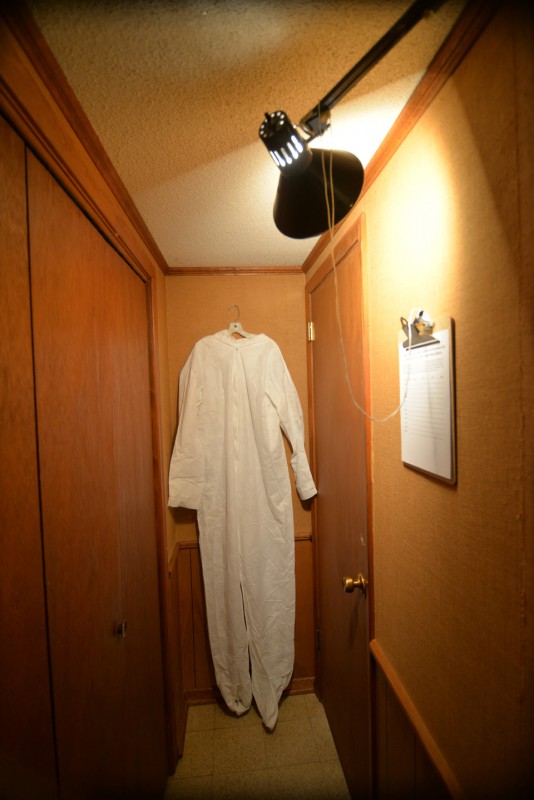
Installation view of Target Classes. Photo: Sean Smuda
Sean
Those are the sorts of connections I want to make with people through my art. I want to empower them with its ideas, and also with what it does — its poetics, aesthetics, and conscious awareness of where we are in the world, right now. Getting a viewer’s personal and thoughtful response is the true dialogue I’m after, and one that sustains my work in ways that walls and cash do not.
Nickelangelo
Which is why liminal spaces like TuckUnder are so important to our local art ecosystem. Here’s a guy opening up his house to the world for one simple, pure reason: He loves art and wants to share it. It’s like what you did with Shoebox.
Sean
I’m afraid we are losing touch with interpersonal relationships. I want social immediacy, not social media. Hence, my launching of some intimate residency projects, such as the one I did here at TuckUnder – they’re residencies which will, henceforth, be available by request, barter, and whatever capitalist/humanist paradigm you care to flaunt. Brian Cornell, hit me up!
______________________________________________________
Related exhibition and event information:
An exhibition dialogue and screening will take place Tuesday, November 11 at TuckUnder. Doors will open at 6 pm, and the talk will begin at 7pm, followed by a video screening of The 36th Chamber of Shaolin, at 5120 York Street, Minneapolis, 55410. 36CHMBRZ and Sean Smuda’s installation in the Leaky Sink Gallery, Target Classes, are both open for unstructured hours Wednesday through Sunday and by appointment until November 23, 2014.
Sean Smuda is a visual artist working in Minneapolis, Minn. who makes work in a variety of mediums, including photography, sculpture, music, and performance. His work is in the permanent collection of the Walker Art Center. Recent projects have taken place in Antarctica, Iceland, China, Tibet, and Iraq. At Les Rencontres Photographiques d’Arles, 2012, curator Jean-Claude Lemagny recommended his work for acquisition by the French National Library. Since 2003, he has curated the Shoebox Gallery at the corner of Chicago and Lake street in Mpls, and will continue to do so until its imminent demise. www.seansmuda.com
Nickelangelo (the artist formerly known as Nick Vlcek) jumped ship from the world of commercial art into the frothy seas of the contemporary, and has been struggling ever since to keep his head above the waves. His work is currently showing at the Ramsey County Historical Center and the Shoebox Gallery. 36CHMBRZ at TuckUnder Projects is his first solo exhibition.